Related Research Articles

Seville is the capital and largest city of the Spanish autonomous community of Andalusia and the province of Seville. It is situated on the lower reaches of the River Guadalquivir, in the southwest of the Iberian Peninsula.
The Abbadid dynasty or Abbadids was an Arab Muslim dynasty which ruled the Taifa of Seville in al-Andalus following the downfall of the Caliphate of Cordoba in 1031. After the collapse, they were the most powerful Taifa and before long absorbed most of the others. Abbadid rule lasted from about 1023 until 1091, but during the short period of its existence it exhibited singular energy and typified its time.

A crown is a traditional form of head adornment, or hat, worn by monarchs as a symbol of their power and dignity. A crown is often, by extension, a symbol of the monarch's government or items endorsed by it. The word itself is used, particularly in Commonwealth countries, as an abstract name for the monarchy itself, as distinct from the individual who inhabits it. A specific type of crown is employed in heraldry under strict rules. Indeed, some monarchies never had a physical crown, just a heraldic representation, as in the constitutional kingdom of Belgium.
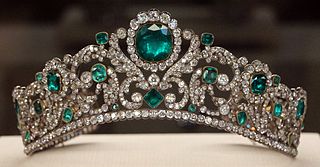
A tiara is a jeweled head ornament. Its origins date back to ancient Greece and Rome. In the late 18th century, the tiara came into fashion in Europe as a prestigious piece of jewelry to be worn by women at formal occasions. The basic shape of the modern tiara is a (semi-)circle, usually made of silver, gold or platinum, and richly decorated with precious stones, pearls or cameos.

Thor is a prominent god in Germanic paganism. In Norse mythology, he is a hammer-wielding god associated with lightning, thunder, storms, sacred groves and trees, strength, the protection of humankind, hallowing, and fertility. Besides Old Norse Þórr, the deity occurs in Old English as Þunor, in Old Frisian as Thuner, in Old Saxon as Thunar, and in Old High German as Donar, all ultimately stemming from the Proto-Germanic theonym *Þun(a)raz, meaning 'Thunder'.

The taifas were the independent Muslim principalities and kingdoms of the Iberian Peninsula, referred to by Muslims as al-Andalus, that emerged from the decline and fall of the Umayyad Caliphate of Córdoba between 1009 and 1031. They were a recurring feature of al-Andalus history.

Al-Mu'tamid Muhammad ibn Abbad al-Lakhmi, also known as Abbad III, was the third and last ruler of the Taifa of Seville in Al-Andalus, as well as a renowned poet. He was the final ruler of the Arab Abbadid dynasty of Seville, before being deposed by the Almoravids in 1091.

Larache is a city in northwestern Morocco. It is on the Moroccan coast, where the Loukkos River meets the Atlantic Ocean. Larache is one of the most important cities of the Tanger-Tetouan-Al Hoceima region.
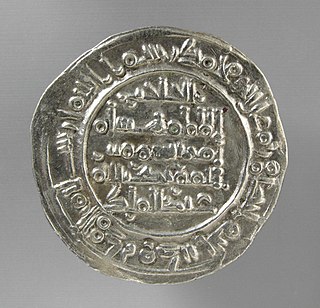
Hisham II or Abu'l-Walid Hisham II al-Mu'ayyad bi-llah was the third Umayyad Caliph of Spain, in Al-Andalus from 976 to 1009, and from 1010 to 1013.

Cabra is a municipality in Córdoba province, Andalusia, Spain and the site of former bishopric Egabro. It lies along the route between Córdoba and Málaga in the south of Spain. It is an entrance point to the Parque Natural de las Sierras Subbéticas.
Abū al-Walīd Aḥmad Ibn Zaydouni al-Makhzūmī (1003–1071) or simply known as Ibn Zaydoun or Abenzaidun was an Arab Andalusian poet of Cordoba and Seville. He was considered the greatest neoclassical poet of al-Andalus.

Medina de Rioseco is a municipality located in the province of Valladolid, in the autonomous community of Castile and León and Spain. According to a 2011 census (INE), the municipality has a population of 4,967 inhabitants.
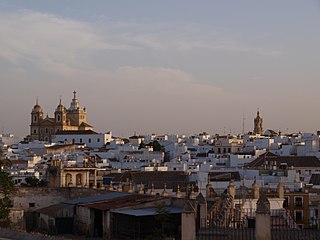
Marchena is a town in the Province of Seville in Andalusia, Spain. From ancient times to the present, Marchena has come under the rule of various powers. Marchena is a service center for its surrounding agricultural lands of olive orchards and fields of cereal crops. It is also a center for the processing of olives and other primary products. Marchena is a town of historic and cultural heritage. Attractions include the Church of San Juan Bautista within the Moorish town walls and the Arco de la Rosa. The town is associated with the folkloric tradition of Flamenco. It is the birthplace of artists including Pepe Marchena and Melchor de Marchena, guitarist.
Abbadi or Abbadids is a prominent Arab Muslim dynasty, and one of the largest Arab tribes whose genealogy can be traced back to the Qahtanian "Qahtan" Lakham tribe. However, the tribe's origins are subject to scholarly debate. While some scholars link Abbadi to the Lakhm tribe, others propose a connection to the Judham tribe, which is a sister tribe of Lakhm. Both Lakhm and Judham have been historically documented to have inhabited the same regions in the Arab Levant and Saudi Arabia. Moreover, many researchers posit that Prophet Shuaib belonged to the same tribe (Judham). Abu Ubaid al-Bakri, an erudite Andalusian Arab geographer, writer, polymath, and botanist born in 1030 AD, expounded on the subject, stating that Prophet Shuaib hailed from the Judham tribe and are recognized as the sons-in-law of Prophet Moses.
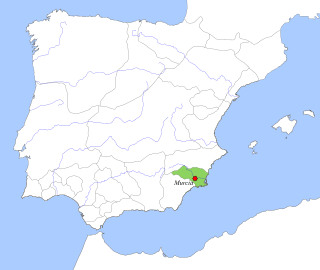
The Taifa of Murcia was an Arab taifa of medieval Al-Andalus, in what is now southern Spain. It became independent as a taifa centered on the Moorish city of Murcia after the fall of the Umayyad Caliphate of Córdoba. The Moorish Taifa of Murcia included Albacete and part of Almería as well.

The Treasure of El Carambolo was found in El Carambolo hill in the municipality of Camas, 3 kilometers west of Seville, on 30 September 1958. The discovery of the treasure hoard spurred interest in the Tartessos culture, which prospered from the 9th to the 6th centuries BCE, but recent scholars have debated whether the treasure was a product of local culture or of the Phoenicians. The treasure was found by Spanish construction workers during renovations being made at a pigeon shooting society.
E'etemad al-Rumaikiyya was an Andalusian poet, consort of Emir Al-Mu'tamid of Seville. She is believed to have been born between 1045 and 1047.
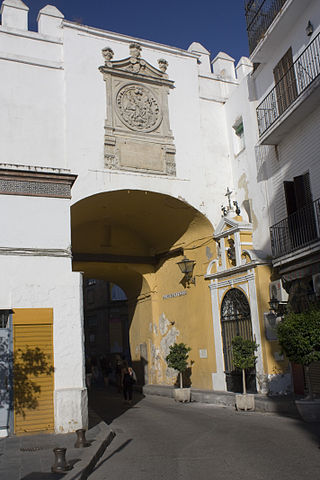
.

Portrait of Marsilio Cassotti and His Bride Faustina is a 1523 oil-on-panel painting by Lorenzo Lotto, now in the Prado Museum in Madrid. It is signed and dated "L. Lotus Pictor / 1523". It is the first known marriage portrait produced in Italy, inspired by prints from Germany and the Low Countries.
The literature of al-Andalus, also known as Andalusi literature, was produced in al-Andalus, or Islamic Iberia, from the Muslim conquest in 711 to either the Catholic conquest of Granada in 1492 or the expulsion of the Moors ending in 1614. Andalusi literature was written primarily in Arabic, but also in Hebrew, Latin, and Romance.
References
- ↑ E.J. Brill's First Encyclopaedia of Islam 1913-1936. Brill. 1993. ISBN 9789004097896.
- ↑ Pike, Ruth (1961). "Seville in the Sixteenth Century". The Hispanic American Historical Review. 41 (1): 1–30. doi: 10.1215/00182168-41.1.1 .
- 1 2 The History of the Mohammedan Dynasties in Spain, Volume 1. 1840.
- ↑ Urquhart, David (1850). The Pillars of Hercules; Or, A Narrative of Travels in Spain Volume 2.